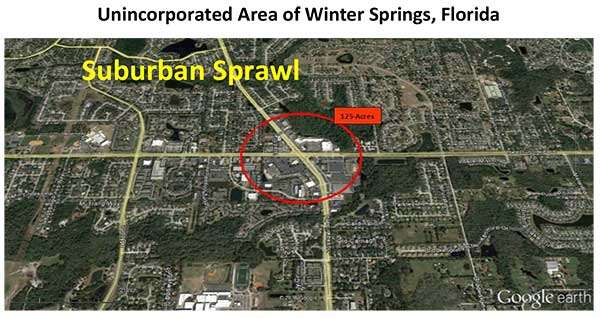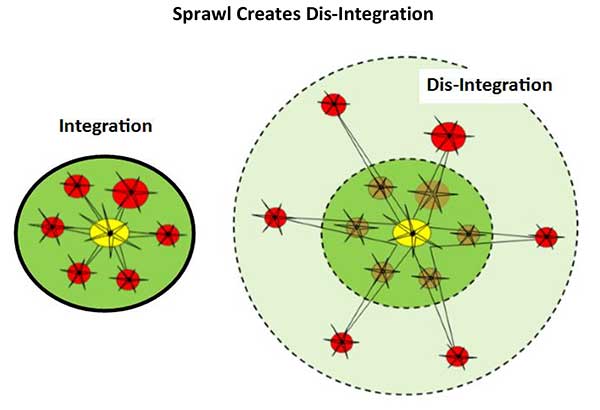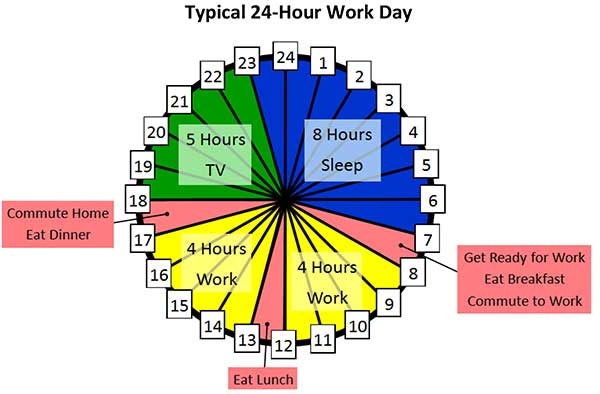 P.O. Box 941120 , Maitland , FL 32794-1120
P.O. Box 941120 , Maitland , FL 32794-1120 dmarks@cfl.rr.com
dmarks@cfl.rr.com  407.694.7040
407.694.7040
In the past, pre-automobile, one’s daily activity would have been in close proximately to where one lived. Activities would have been integrated within one’s community. In today’s world, many of one’s daily activities have been pulled outside of a traditional community scale. In most cases, one’s daily activities are no longer walkable. This sprawling pattern has dis-integrated the community, creating isolated islands of activity, in which one travels by car between places such as; home, work, recreation, nature, and shopping.
Suburban Sprawl - The unincorporated area of Winter Springs, Florida is a good example of suburban sprawl, that is so typical of post-World War II development across the United States. The neighborhood and community retail is located at the intersection of two of the area’s arterial roads. For most people in the area, the only way to get to these shopping centers is to use their car. The subdivisions are separated from each other by arterial roads. It is as if these communities were designed by car manufacturers and petroleum companies that want us to maximize our use of the car. Many of the subdivisions have no amenities, once you are home, there is nothing to walk to. Almost all the land is developed, unless it is wet, leaving little of nature to experience.
This sprawling community is no longer at a human scale. The 125-acre area below, consists mainly of commercial establishments. This commercial core is now just part of a much larger community. The human scale is lost, along with one’s connection with community, and nature!
The reason this type of sprawling development is so prevalent is that it is cheap and fast to build. But, it is not sustainable. Long term, it is not good for the individual, the family, the community, or the environment. Communities need to have a master plan for how they are going to be developed. Without such a plan, you get this chaotic sprawl, and all its long-term consequences.

Dis-Integration - Below is a diagram of a healthy integrated community, and a sprawling dis-integrated community. The yellow area is the core of the community, it functions as its DNA, directing activities within the community. The red areas are villages or districts; they function as organs of the community. The integrated community functions like a healthy cell that is properly scaled to carry out all its needed activities, while the dis-integrated community no longer functions as a healthy system, awareness, access, control, and care of the outlying areas are all diminished. Aristotle’s required proximity to friends and its resulting happiness is also lacking.

Impoverished Lifestyle - Below is a 24-hour clock showing the typical work day of a person in America. We sleep 8-hours, work 8-hours, and watch TV for about 5-hours (based on Nielen ratings). This leaves us only three hours per day to get ready for work, communte to and from work, and eat three meals. If we are having any face to face time to socialize, it is occuring with family over meals, or with coworkers. This does not look like a very enriching lifestyle. It looks like we have turned ourselves into passive organisms that are not fully alive! We watch friends on tv, instead of interacting with real friends. We need to reintegrate ourselves back within our communities and environments, creating a much healthier and enriching life.

Read Chapter 16: Biological Principles Applied to Building Healthier Communities